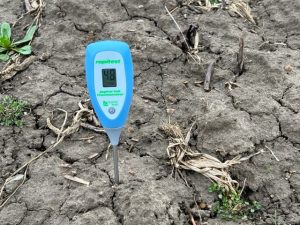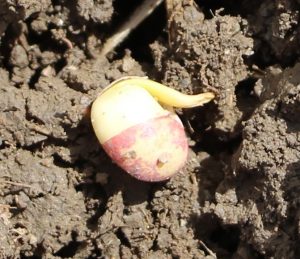Soil Temperature and Early Planting Conditions
By Tony Nye, OSU Extension Educator, AgNR, Clinton County, and Dusty Sonnenberg, CCA, Ohio Field Leader, a project of the Ohio Soybean Council and soybean check-off.
It has been said that seed has the greatest yield potential when it is still in the bag. The problem is that if seed is never planted, it will never have an opportunity to reach it’s potential. Once the seed planted, the yield potential is either maintained or declines. It never increases.

Many farmers will agree that the planting process is the most critical to get correct on the farm. No one likes to replant or spot-in crops. While the yield potential may be similar depending on the time of replant, compared to first planting, the expenses are near double with additional seed, fuel, equipment wear and labor involved.
The goal is to get the seed in the ground and for each seed to germinate and emerge quickly and uniformly. Seeds require a certain temperature in order to germinate. Each plant has a specific optimum and a range within which germination will occur. The closer the temperature is to optimum the quicker germination will occur.
Soil temperatures can be monitored by using a basic soil temperature thermometer.  These can be purchased online or at many garden centers, ranging from $10-$20 and are very beneficial in determining what the soil temperature is in the seed zone. Typically soil temperatures are measured in the 2-4 inch zone (5-10 CM).
These can be purchased online or at many garden centers, ranging from $10-$20 and are very beneficial in determining what the soil temperature is in the seed zone. Typically soil temperatures are measured in the 2-4 inch zone (5-10 CM).
Another way to monitor the soil temperature is by visiting the Ohio State University (OSU) College of Food Agricultural and Environmental Sciences (CFAES) Weather System Website. This site provides current and historical data from both OSU CFAES and USDA weather stations across Ohio. Each station listed will provide data of the current conditions and allows users to select a date range for past weather information. Charts for yearly summaries, daily overviews, Growing Degree Day (GDD) graphs, precipitation and soil temperature graphs, and historical frost dates are also included.
According to Ohio State University Crop Specialists Alexander and Laura Lindsey, planting when conditions are adequate (soil temperatures above 50°F and greater than 45% plant available water content) is recommended for corn and soybeans.
The first step in germination is the process of imbibition, or absorbing water from the soil for 24-48 hours after planting. Generally, seeds need to return to their moisture levels at physiological maturity (30% moisture for corn, 50-55% for soybean) before germination begins. Moisture is critical for germinating seeds. Seeds need a moist but not soggy environment.
In the past there have been cases of imbibitional chilling occur in parts of Ohio when soil temperatures were warm (>50°F) but then there was snow or cold rain within 12 hours of planting, which damaged seedlings and contributed to poor stands or seed mortality. This led to a replant situation.
The second phase of germination is called the lag or activation phase. It involves seed reserve mobilization and cell wall loosening. Cool temperatures can slow this phase, which can affect how quickly the seeds will sprout. The final step is growth and is marked by radicle emergence.  The seed is now fully committed to growth and must rely on internal food reserves to fuel growth until it emerges and can start photosynthesizing.
The seed is now fully committed to growth and must rely on internal food reserves to fuel growth until it emerges and can start photosynthesizing.
Rate of growth is influenced by accumulated growing degree days (GDDs) or heat units. If days turn cooler after planting, fewer GDDs are gained each day resulting in more days in the soil without photosynthesizing. This can deplete seed reserves.
Late frosts can damage leaf tissue. For soybean, the growing point is above the soil surface at emergence (VE growth stage). If freeze damage occurs below the cotyledons, the plant will not recover. The last freeze date in Ohio (air temperature ≤32°F) for the past five years has ranged from as early as April 2 to as late as May 16. However, a temperature of ≤32°F does not necessarily mean there will be freeze damage. Freeze damage can be variable based on soil moisture, landscape position, and crop residue in the field. Temperatures near the soil are often warmer, especially when the soil is wetter.